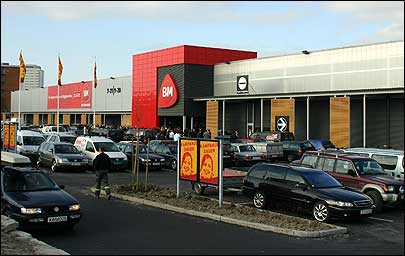Rautakesko, a Finnish retailer of hardware, tools, household appliances and building materials, with stores in Russia, Belarus and six other Baltic or Nordic countries, is employing active Wi-Fi-based RFID tags to obtain information regarding customer behavior, in order to improve the layouts of its stores. The company is using Ekahau‘s real-time location system (RTLS), which it most recently installed at its Byggmakker location in Trondheim, Norway, and at its K-rauta store in Örebro, Sweden.
By analyzing customers’ shopping behavior, Rautakesko hopes to improve each store’s layout, in order to draw customers to products that are top sellers, improve traffic flow throughout each store and reduce out-of-stocks. Because Rautakesko operates 320 stores in eight separate countries, each location’s layout needs to be tailored to the shopping patterns of its specific customer base—though traditionally, the stores were all built relatively similarly. By improving its understanding of a store’s shopping patterns, the company can better determine what the layout should be, says Jouni Jaakkola, Rautakesko’s concept manager.

The retailer undertook its first in-store study in 2006, at its K-rauta store in Porvoo, Finland, where a number of customers wore active Wi-Fi RFID tags around their necks while shopping. The tags transmitted information to wireless 802.11 access points within the store.
In 2007, Rautakesko held a similar study at a newly constructed K-rauta store in Tondi, Estonia, and at another K-rauta location in Örebro, Sweden. Because the Tondi site was newly constructed, the company was able to lay it out based on the specific needs of the earliest customers who passed through the store, according to Konsta Kuokkanen, the firm’s project manager. By contrast, the Örebro store had been designed based on an earlier concept, in which all locations were laid out in the same manner. “So this was the first time when we were surveying the old-store concept,” Kuokkanen says.
In 2008, the company also began conducting its study at the Byggmakker store in Trondheim.
With each pilot, as customers enter a store, an employee offers them one of 30 Ekahau Wi-Fi tags. About the size of matchbook, each device transmits its unique ID number at a rate of every three seconds. The tag’s battery has a life of approximately five years, and can transmit to any Wi-Fi access point. The tag also has two buttons that are not currently being used but that could serve as a customer service request button in the future, says Tuomo Rutanen, Ekahau’s VP of business development.
If a customer agrees to wear the tag, the worker inquires about that person’s age bracket and inputs that data, along with the customer’s gender, into a software application where it is linked to the ID number, as well as the time and date. The shopper proceeds through the store and on to the checkout point, then returns the tag at the exit, where it can be cleared from the system for reuse.
In the meantime, as the patron browses the store, wireless access points receive transmissions from the tag, and the Ekahau Positioning Engine software server—with an Intranet connection to Rautakesko’s back-end system—collects that ID number and analyzes the tag data. Ekahau Vision software provides a display of the store’s floor plan, with an icon representing each customer tag. The system locates those tags through Ekahau algorithms that rely on received signal strength indicators (RSSI). In an ideal environment, Rutanen says, Ekahau can achieve an accuracy of 1 to 3 meters (3.3 to 10 feet).
The staff can search one of multiple tags in real time, or utilize the data for marketing research, such as determining whether customers purchased items they stopped to view on display, which way traffic flows throughout the store, and at which times of the day the checkout counters are backed up on account of excess traffic or insufficient staff. They can also determine which demographic segments—such as age and gender—are interested in a particular product, and when that demographic shops.
The Ekahau system works with the stores’ existing Wi-Fi networks, with approximately 20 LAN wireless access points in place for voice and data, says Antti Korhonen, Ekahau’s president and CEO, thus saving the retailer time and money that would otherwise be spent installing RFID interrogators. In several cases, Rautakesko’s stores did not yet have a Wi-Fi network, so Ekahau installed one for them.
The earliest studies, Kuokkanen says, simply involved testing the Ekahau hardware and monitoring traffic movement in real time. But in 2008, he adds, the company began to develop business analysis related to the studies.
Thus far, Kuokkanen reports, Rautakesko has been happy with the results. “We get valuable information for our store concept design and planning,” he says, adding that in the future, the company intends to implement such RFID deployments at three or four stores per year.
“We hope that we can learn about time spent in our departments and new showroom—are there some showrooms that are more interesting, or do the showrooms attract customers better in some other location?” Kuokkanen states. “We hope that we can find some customer flow connections between some departments—for example, the bathroom showroom to the tiling department.”


